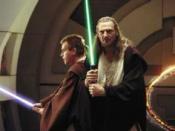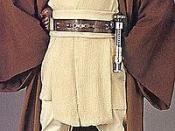As the fluorescent lights dim, a tense hush swallows the audience. Yet as the room itself darkens, the vast movie screen brightens in contrast, and the peal of a single trumpet heralds a familiar tune. "It is a period of civil war. Rebel spaceships, striking from a hidden base, have won their first victory," the screen announces. Fans' eyes dart to read this opening of Star Wars: A New Hope, now a pinnacle in the domain of science fiction. Millions applaud its classical texture: the slight taste of fairy tale archetypes that appeals to a variety of audiences. These same paradigms also complement an underlying theme of the trilogy. Within Star Wars: A New Hope and Return of the Jedi, archetypes exist that exemplify the theme that good can triumph over evil through perseverance.
Primarily, symbolic archetypes flourish within George Lucas' masterpiece. As an example, the contrast of colors in Luke Skywalker's clothing represents a loss of innocence in the main character.
As a teenager in Star Wars: A New Hope, he wears clothes of all white, representing his pureness as a young adult. Swept away by adventure, Skywalker can no longer cling to his security blanket of virtue after learning about the force and the evil of the Empire. This change in him is noticeable when, in Return of the Jedi, Luke discards his former white and chooses a more somber black. His attire complements his morose, yet determined heart. Also, this contrast of white and black is evident in the setting of the two movies. The Rebel base consists of mostly light backgrounds, while the Death Star and the home of Jabba the Hutt appear dark and mysterious with evil forces. This perceptible difference shows that the place with good forces, the Rebel base, seems flourished with light...


